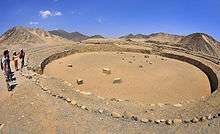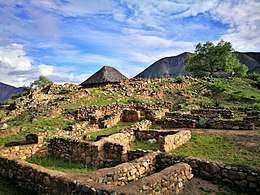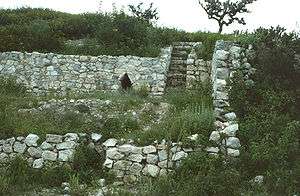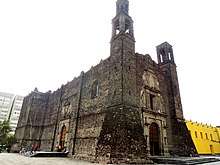List of oldest buildings in the Americas
This article lists the oldest known surviving buildings constructed in the Americas, including on each of the regions and within each country. "Building" is defined as any human-made structure used or interface for supporting or sheltering any use or continuous occupancy. In order to qualify for this list a structure must:
- be a recognisable building;
- incorporate features of building work from the claimed date to at least 1.5 metres (4.9 ft) in height;
- be largely complete or include building work to this height for most of its perimeter.
- contains an enclosed area with at least one entry point.
Pre-Columbian era
| Name | Image | Note | Country | Historical region | First Built | Use | Source |
|---|---|---|---|---|---|---|---|
| Sechin Bajo | A large archaeological site with ruins dating from 3500 BCE to 1300 BCE | Department of Áncash, Peru | 3500 BC | Administrative-Ceremonial center | [1] | ||
| Pyramids of Caral |  | These pyramids predate the Egyptian pyramids by around 100 years | Department of Lima, Peru | Caral civilization | 2600 BC | Temples and residential buildings | [2] |
| Kotosh |  | Archaeological site consisting of buildings with six periods of continuous occupation. | Huánuco, Peru | 1800 BC | Temple | [3] | |
| Garagay |  | One of the largest centers of pre-Columbian culture on Peru's central coast | Lima, Peru | 1400 BC | Temples | [4] | |
| Yucuita |  | Founded by the Mixtec civilization in the pre-Classic Period | Oaxaca, Mexico | Mixtec civilization | 14th century BC | Ceremonial center and a square | [5] |
| San José Mogote |  | San José Mogote was the largest and most important settlement in the Valley of Oaxaca during the Early and Middle Formative periods | Oaxaca, Mexico | Zapotec civilization | 1300 BC | Town | [6] |
| Chavín de Huantar |  | Occupation at Chavín de Huántar has been carbon dated to at least 3000 BCE | Department of Áncash, Peru | Chavín culture | 1200 BC | Religious center | [7] |
Colonial era
| Name | Image | Note | Location | Historical region | Built | Source |
|---|---|---|---|---|---|---|
| Basilica Cathedral of Santa María la Menor |  | It was the first and oldest cathedral established in the Americas. | Santo Domingo, Dominican Republic | Columbian Viceroyalty, Spanish Empire | 1514-1541 | [8][9] |
| Monasterio de San Francisco |  | It was the first and oldest monastery built in the Americas. | Santo Domingo, Dominican Republic | Columbian Viceroyalty, Spanish Empire | 1509-1560 | [9] |
| Hospital San Nicolás de Bari |  | It was the oldest hospital built in the Americas. | Santo Domingo, Dominican Republic | Columbian Viceroyalty, Spanish Empire | 1503 | [9][10] |
| Ozama Fortress |  | It is the oldest military construction of European origin in the Americas. | Santo Domingo, Dominican Republic | Columbian Viceroyalty, Spanish Empire | 1502-1508 | [9][11] |
| Palace of Cortés |  | It is the oldest conserved colonial-era civil structure in the continental Americas. | Cuernavaca, Mexico | Viceroyalty of New Spain, Spanish Empire | 1523-1528 | [12][13] |
| Colegio de Santa Cruz de Tlatelolco |  | It was the first European school of higher learning in the Americas and the first major school of interpreters and translators in the New World. | Mexico City, Mexico | Viceroyalty of New Spain, Spanish Empire | 1536 | [14][15] |
| Biblioteca Palafoxiana |  | It is the first and oldest public library in the Americas. | Puebla City, Mexico | Viceroyalty of New Spain, Spanish Empire | 1646-1773 | [16][17][18] |
References
- "Oldest Urban Site in the Americas Found, Experts Claim". National Geographic News. 26 February 2008.
- "Sacred City of Caral-Supe". UNESCO World Heritage Centre.
- "Kotosh: las manos que se cruzan en el tiempo" (PDF). Arqueología del Perú (in Spanish).
- Lizardo Tavera (2000). "Garagay". Arqueología del Perú (in Spanish). Archived from the original on 10 March 2009.
- "Zona Arqueológica de San Juan Yucuita". Instituto Nacional de Antropología e Historia. 11 June 2015.
- "Current Research (Kent V. Flannery)". University of Michigan Museum of Anthropology. Archived from the original on 2007-12-29. Retrieved 2005-11-18.
- "Chavin (Archaeological Site)". UNESCO World Heritage Centre.
- "Basilica Cathedral of Santa María la Menor". 5albemarleway.co.uk. 15 August 2018.
- "Colonial City of Santo Domingo. Outstanding Universal Value". UNESCO World Heritage Centre website.
- "Ruinas del Hospital San Nicolás de Barí". Lonely Planet.
- "The Fortress of Santo Domingo also known as Fortaleza Ozama". colonialzone-dr.com.
- John Jeffries Martin (2007). The Renaissance World. New York: Routledge. p. 123. ISBN 978-0-415-33259-0.
- Elizabeth Zach (6 April 2018). "Cuernavaca: A side trip into opulence, only an hour away from Mexico's capital". The Washington Post.
- Steck; Francis Borgia (1936). The first college in America: Santa Cruz de Tlatelolco. Achievement and influence of Santa Cruz de Tlatelolco. Washington DC.
- Lourdes Arencibia Rodriguez (2006). "The Imperial College of Santa Cruz de Tlatelolco: The First School of Translators and Interpreters in Sixteenth-Century Spanish America". Charting the Future of Translation History. Perspectives on Translation. University of Ottawa Press. pp. 263–275. ISBN 9780776626208. Retrieved 2017-09-27.
- "Biblioteca Palafoxiana" (PDF). UNESCO. Retrieved 27 April 2012.
- Brescia, Michael M. (July 2004). "Liturgical Expressions of Episcopal Power: Juan de Palafox y Mendoza and Tridentine Reform in Colonial Mexico". The Catholic Historical Review. 90 (3): 497–518. doi:10.1353/cat.2004.0116. JSTOR 25026636.
- Sherman, William H. (2010). "Palafoxiana, Biblioteca". In Suarez, Michael F.; Woudhuysen, H. R. (eds.). The Oxford Companion to the Book. Oxford University Press.
This article is issued from Wikipedia. The text is licensed under Creative Commons - Attribution - Sharealike. Additional terms may apply for the media files.